This spine-chilling river safari is why some of us come to Africa
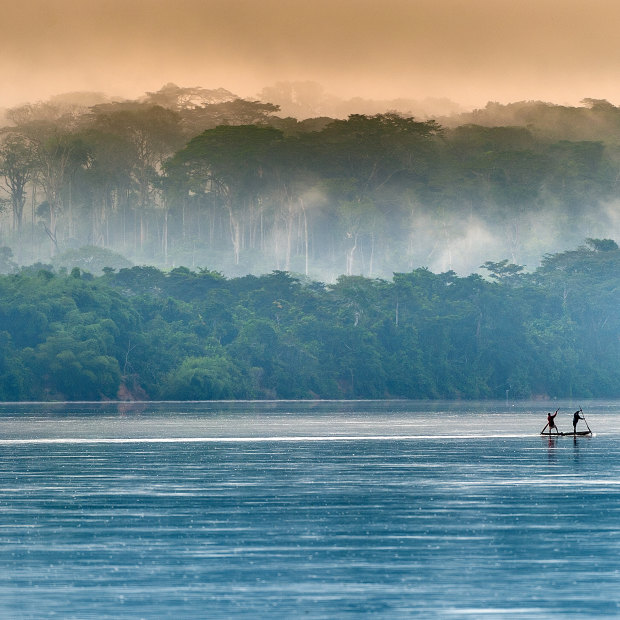
Morning fog on the Sangha River.Credit: Getty Images
The boy is hypnotised, staring at the glass in my hand, eyes wide. I give it a swirl and the ice chimes against the side. I’m used to stares in Africa, but this is something beyond curiosity, a naked, adolescent wonder. I fish out a chunk and he holds it, eyes wide, while the water pools in his palm and drips and glistens on the riverbank. He’s never seen anything like it. Is it made from glass he asks? I’m stuck. How to explain ice to someone who lives in a village with no electricity?
I’m standing on a muddy riverbank at a village in West Africa’s Republic of Congo. At my feet the Sangha River, one of the tributaries of the Congo, uncoils from the forest. The world’s second-largest tropical rainforest after the Amazon, the Congo River basin is home to western lowland gorillas, forest elephants, endemic species including bonobos, sun-tailed monkeys, black colobus, okapi and more than 20,000 plant species. Ten per cent of the oxygen we breathe comes from this forest.
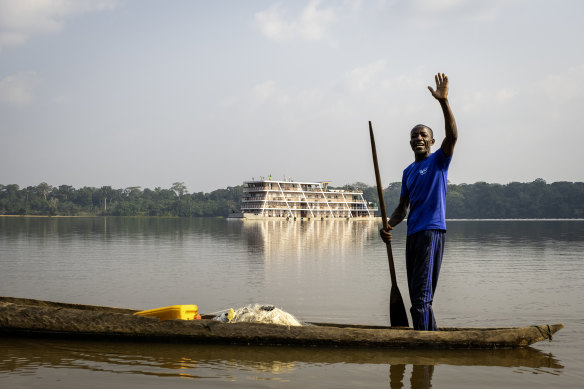
A fisherman and the Princesse Ngalessa.
To the north lies the Central African Republic (CAR), to the east the Democratic Republic of the Congo.
The Congo is a major highway for cargo vessels, a giant tap root worming its way into the heart of Africa, but the Sangha is shallow. For most of the year its waters barely cover the sandbanks. Dugout canoes are the only river traffic, villages are sparse, roads are almost non-existent and the forest is a solid wall of giant trees, meshed with vines.
I’m on a 12-day Classic Safari Company cruise along the Sangha and Congo rivers aboard Princesse Ngalessa, a modestly luxurious riverboat operated by Brazzaville-based Ducret Expeditions. For the first time, travellers from the outside world can make the journey along the Sangha and the Congo in air-conditioned suites with a well-stocked bar and a daily laundry service.
The cruise begins at Ouesso, in the north of the Republic of Congo, but after one night on board we’re whisked off for a seven-hour speedboat ride to a wildlife lodge in Dzanga-Sangha Special Reserve, a UNESCO World Heritage Site tucked into the southern corner of the neighbouring Central African Republic.
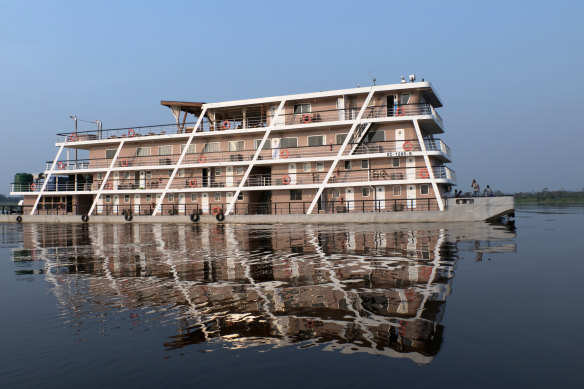
Smooth passage on riverboat Princesse Ngalessa.Credit: Sheri Bluestein
The chance to visit a family of western lowland gorillas in the reserve is one of Expedition Ducret’s core promises, but when we reach Doli Lodge, tragedy has struck. The gorilla family, which has been habituated to humans over several years, has lost its dominant silverback. The big male who protects and leads the females and infants of his extended family has been killed by a rogue male. Now the group is vulnerable and visiting them is out of the question.
“Never mind,” says Harold, Expeditions Ducret’s senior guide, “we’ll take you to the bai, you won’t be disappointed.” For 45 minutes we sweat and slip through the forest, tripping on foot-snagging vines and wading through streams.
It’s a different world from the Africa seen from the back of a safari jeep, but there are rewards. There are termite colonies chewing with a crackling sound like rain falling on leaves and hornbills untangling themselves from the forest, rising with great draughts of air from beating wings. Once the branches shake and a troop of long-haired colobus monkeys swings through the canopy like they’re on a zipline.
We emerge to a sward, a broad expanse with a stream running through the middle and about 70 elephants, drinking, wallowing in the stream and spraying themselves with ochre mud. Rich in minerals, water and vegetation, the bai, a grassy clearing in the forest, is a gourmet restaurant, spa and playground rolled into one for forest elephants.
From our elevated perch in a hide we spend a couple of hours watching the dramas below.
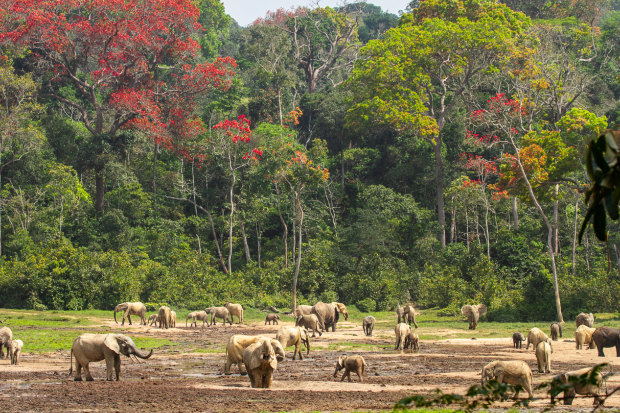
The bai, a grassy clearing, is a gourmet restaurant, spa and playground rolled into one for forest elephants.Credit: Nuria Ortega
The elephants are in a slow and constant flux, moving from one hole to another, trunks raised as they greet one another, but there’s also aggro. In front of the hide is a favoured spot where an elephant calf is drinking near its mother who shoos away an interloper. Eventually, she wanders off and the bandit returns, gives baby a shove in the rear and takes over.
After three nights at Doli Lodge, we schuss downriver to rejoin the Princesse Ngalessa back in Republic of Congo and next morning, after a breakfast of croissants, crepes, omelettes and coffee, our 1200-kilometre journey begins.
It’s a relaxing morning, watching the forest drift past, the coming and going of garfish-thin dugout canoes and sometimes a house in a clearing along the bank, with boisterous kids waving and shouting at our floating hotel.
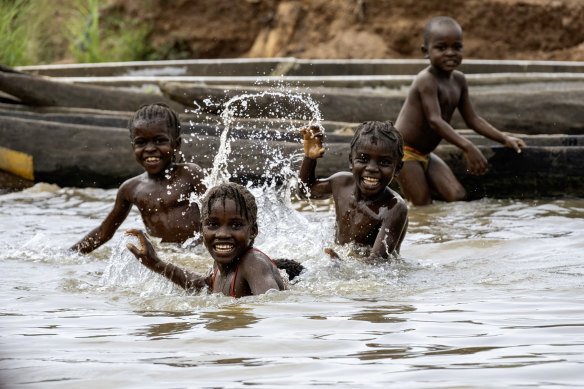
River greetings… village children splash a welcome in the Sangha River.
By mid-afternoon we reach the village of Tokou, and a welcome from a massed choir of 70 villagers singing, clapping and serenading us as we climb the muddy slope. The villagers are a mix of Bantu, the dominant ethnic group of sub-Saharan Africa, and Baka, one of the groups that the world lumps together under the pygmy tag, although the name is now pejorative. Accompanied by swarms of children we pass between mud and lath houses to a clearing. The chief makes a speech and shoos the women to one side, men to the other, and they form a circle and dance in a hip-shaking, shimmying Congo conga.
The Baka are also known as the people of the forest, one of the Indigenous groups of the Congo rainforest. Although they no longer move from place to place they still live as hunter-gatherers. By necessity their lives are pared to the bare essentials, but their forest home supplies them with food, shelter and medicine.
It feels like first contact. This is only the second cruise of the Princesse Ngalessa. Will they keep this up after cruise number five, or 25? But they’re doing this for themselves. We’re bystanders, a convenient reason to rekindle songs and dances that might have begun centuries ago. The party continues long after we leave and the ship, hard against the riverbank, turns on powerful shore lights for them and the drums beat into the night.
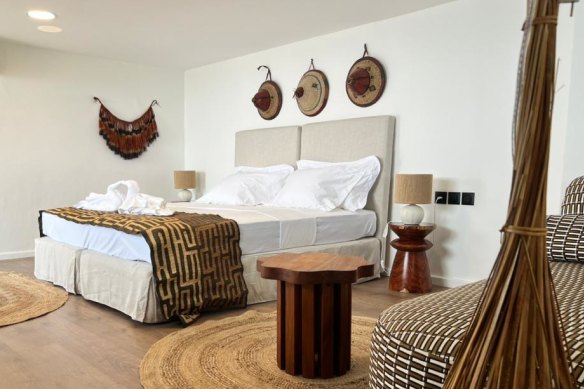
The newly renovated interiors aboard Princesse Ngalessa.
As we motor downstream, there are daily lectures – wildlife, forest ecology, the hidden world of the Baka. One morning when mist hangs in the treetops we board a tender and putter along a narrow river to see tiny kingfishers, jacanas, purple herons, great blue turacos, grey parrots and Hartlaub’s ducks. In muddy villages we watch the processing of manioc, cacao and smoked fish and sample the local firewater, a distilled brew made from corn and strong enough to blow your head off, $2 a bottle.
The river slowly loses its fragile innocence. The villages grow larger, thatched roofs give way to corrugated iron and marshland and cultivated gardens replace the swollen forest. We’ve left the hunter-gatherer wilderness for farmers’ fields. Then the river broadens, and we leave the 300-metre- wide Sangha for the 10-kilometre span of the Congo River.
We’re in another world. The dugout canoes are joined by dakka dakkas, clattering, diesel-smoking trading boats that ply the river with passengers and freight, named for the incredible noise they make. We pass what appear to be floating villages, huge barges lashed together, pushed along at a snail’s pace by a tug. Sometimes their cargo is logs from the interior, sometimes foam mattresses and canned drinks heading upriver and weirder still, barges with 100 people on board camped around brand-new four-wheel drive Toyotas, Mercedes-Benz and BMWs being ferried from the Central African Republic to Kinshasa, Capital of the Democratic Republic of Congo, formerly Zaire, on the opposite side of the river from Republic of Congo, where they will sell at a higher price.
Ngabe is our last stop on the river. In a clearing in the village a kebe kebe dance is being performed. A group of men sits under a tree, drumming and clapping in syncopated rhythm. Off to one side a long line of women and young girls sway in time to the music.
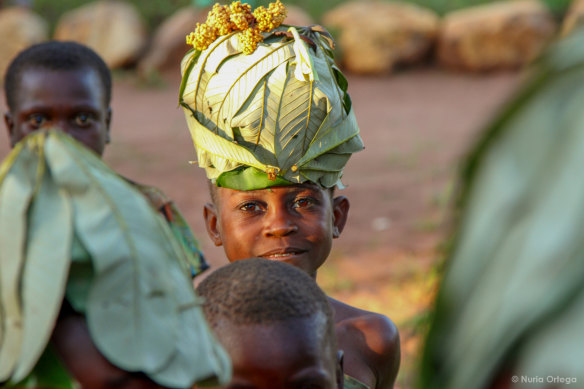
Local headdress.Credit: Nuria Ortega
Now a figure appears from among the houses. Dressed in an all-enveloping raffia cloak covered in feathers, he erupts in a wild, spasmodic dance, whirling around, so the cape fans out like a dervish. The men circle the figure, dancing close as if drawn by a magnetic force but they never touch. Sometimes he squats, tempting them closer, then rears up in a furious burst of energy and they scatter. A spirit from the underworld is being invoked.
Although I shuffle my feet, sway and clap, the dance is a mystery. I’m looking through a keyhole into an unknowable world. This is why some of us come to Africa – not for the fang-and-claw dramas of the savannah, but to feel the spine-chilling majesty of where we all started from.
How many places are there left like this, as strange and incomprehensible to me as a lump of ice is to a boy in a village a thousand kilometres upriver?
The details
Tour
The Princesse Ngalessa travels either upstream on a 15-day itinerary or downstream on a 12-day journey. Both start and end at Brazzaville, capital of the Republic of Congo. The 12-day voyage costs from €7000 ($11,530) a person and includes a visit to Dzanga Sangha National Park (CAR). The 15-day cruise costs from €9525 a person and includes visits to Dzanga Sangha National Park (CAR), Naoubale Ddoki (Republic of Congo) and Bonobos tracking in Tshumbiri (DRC). See classicsafaricompany.com.au
Fly
The most practical route is via Dubai or Doha. From Doha, Qatar Airways has flights to Addis Ababa, from where Ethiopian Airlines has flights to Brazzaville. See qatarairways.com
Stay
Before boarding the Princesse Ngalessa, Expeditions Ducret guests spend one night at the Pefaco Hotel Maya Maya, close to Brazzaville’s International Airport.
Health + security
Before and after booking this trip check the federal government’s Smart Traveller travel advisory on the current health and security recommendations for visits to this part of Africa. See smartraveller.gov.au
The writer travelled as a guest of The Classic Safari Company.